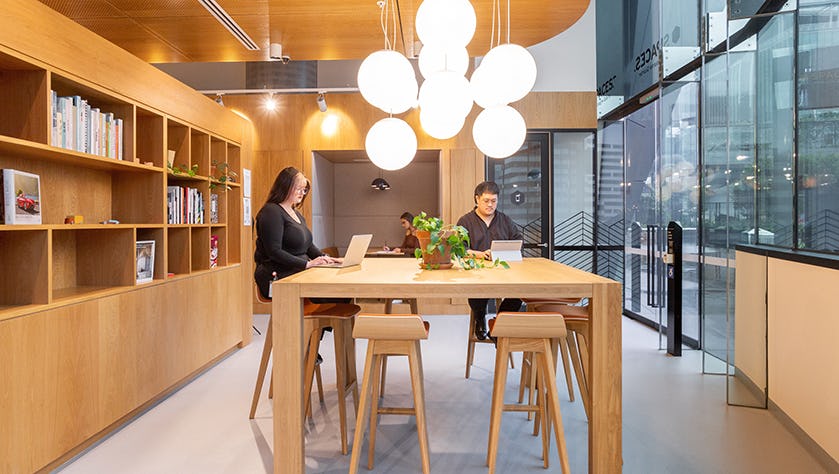
Working from multiple locations is becoming the norm but what is the best way of structuring your days and weeks? There is more than one way to go about it…
Hybrid working allows people to personalise their work schedules to suit their own needs, demands, homelives and capabilities. When you think about it, it makes perfect sense: some people struggle to get into an office for 9am but are far more productive in the evening; new parents may not be able to commute into a city centre office but could spend a few hours a day in a local co-working space; while young recruits may find the cost of commuting to a city centre everyday a drain on their finances.
The beauty of hybrid working is that it doesn’t have to be the same thing for everyone. You can find out what workstyle is best for you and which method best supports your productivity, mental health and wellbeing…
Which hybrid lifestyle best suits you?
1. Structured and predictable
A popular option among many professionals is to split the week up ‘3-2’ so that three days are spent ‘off-site’ at home or in a local flexspace and two days are spent ‘on-site’ working in a central HQ. Many companies are setting expectations to show up at least a couple of days a week so appreciate knowing who will be attending on which days, but usually it’s up to the individual to design their week, which is empowering.
Having a pre-set structure is also useful for teammates, who can plan weekly in-person meetings on a Monday or Tuesday, for example. Meanwhile, employees know that on Wednesdays, Thursdays and Fridays they can fit in a gym workout before walking to a nearby flexspace to get through their emails and focus on ‘deep work’. The model can even benefit freelancers and entrepreneurs who need more structure in their lives.
2. Week-by-week routines
In some cases it can be simpler for teams to take a ‘week-by-week’ approach to hybrid working, whereby everyone operates remotely from home or from a flexspace near where they live for the first five days, and then the following five days, they all regroup in the company office. This means everyone is together at the same time, and benefits from direct face-to-face time and a chance to catch up on projects and workflow, without compromising too much on flexibility and reduced commutes.
3. Ad hoc and reactive
For some people, every day is different so an ‘ad hoc and reactive’ approach to hybrid working will suit best. This is also known as the ‘at will’ model, whereby people choose when and where to work in a way that suits them, and with little forward-planning.
It’s a good idea for employees to come up with a strategy to maximise visibility while minimising stress. Finding an effective way of checking in and letting teammates and employers know where they’ll be, makes this much more achievable.
For a small company it could be as simple as sending an email or updating a shared calendar; while for bigger organisations a more formal way of logging people’s whereabouts will be required. Team Tracker is a good platform – allowing everyone to update when they will be on holiday, see who is travelling for work or manage hot desk allocations.
4. Asynchronous shifts and sprints
Working 9-5, five days a week has been the traditional way of working for more than 100 years but for a good portion of the population, this simply isn’t viable. Whether someone is a parent trying to juggle childcare or an entrepreneur developing a side hustle alongside a full-time job, fitting in an early morning sprint, evening shift and even nights can be opportunities to make progress on a project or fit in some tasks on their ‘to-do’ list.
Responding to this demand, Spaces offices are open 24/7, 365 days a year, meaning that members can still get access to a proper work environment, even if it’s 1am on a Saturday night.
5. Long-distance and fragmented
As business travel makes its return, many professionals will need to hit the road again, and may well be travelling for extended periods rather than taking lots of carbon-heavy flights throughout the year. In this case, hybrid working could take the form of more fragmented use of a dedicated company office space (check-ins might be once a month), complemented by the use of multiple co-working spaces in locations around the world, wherever they happen to be.
Making the transition easier, Spaces offers access to more than 3,000 co-working sites worldwide, which is ideal for the long-distance hybrid worker because you know you’re always going to find a comfortable and professional environment with super-fast wifi, and a good cup of coffee, wherever you are. It’s reassuring to touch down in a new city knowing where you will spend your working days.
Enjoy this? You might also like these other Spaces magazine stories:
Smart ways to boost your wellbeing when you return to the office
Share this article
 Read now Effective ideation: how to host a virtual ‘campfire’
Read now Effective ideation: how to host a virtual ‘campfire’
 Read now Seven tips for embracing hybrid working after a career break
Read now Seven tips for embracing hybrid working after a career break